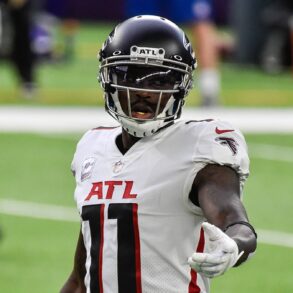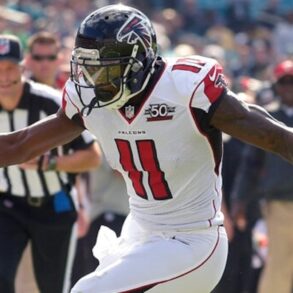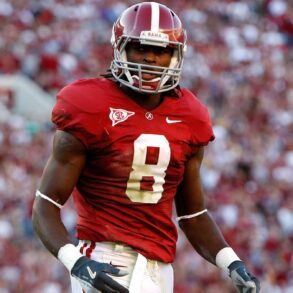On the first day of the rest of his life, Esa Pole was being pulled in two directions.
It was spring of 2021, and he was a 6-foot-6, 290-pound junior college freshman who had never been in a three-point stance with pads on, about to compete on a football field with guys who’d been doing this since they were children. He couldn’t help but feel awkward.
Advertisement
But when he saw how the California sun looked as it beamed through a pair of glass doors onto the field, in that moment, he felt something else.
Hope.
“Football,” Pole says now, “saved my life.”
No player in the 2025 NFL Draft class has a story like that of Esa Pole, the quick and powerful left tackle from Washington State who’s made it to pro football’s doorstep despite never having played a snap in high school. At his pro day, the now 6-6, 323-pound Pole (who did not allow a sack in 850 snaps last season) put up 23 reps of 225 pounds on the bench press.
Five years ago, the first time he ever touched a weight, he could barely push 185 — once.
A year and a half before that first practice in spring of 2021 at Chabot (Calif.) College, Pole was directionless. His plan to pursue basketball after graduating in 2019 from Mt. Eden High in 2019 had fallen through, as no one needed a 6-6 center. Once a bright student with limitless potential, Esa found himself out of school and in a hole, all before his 20th birthday.
He needed a miracle worker. That’s where football — and Pole’s older brother, Toni — enters the story.
Kalafitoni “Toni” Pole is 10 years older than Esa, and he’s been around football all his life. A standout defensive tackle and team captain at Washington State, he is a former Apple Cup hero who lived to battle in the trenches and was good enough for a stint in the NFL. If anyone knew how hard it’d be for a kid with zero prep football experience to make it on a college team, at any level, it was him.
Most would’ve reasoned with Esa — told him it was too late, that it was nearly impossible.
Toni Pole isn’t most people. He’s his brother’s keeper. And he never blinked.
“We’ve had our moments through this. Both sobbing on the phone together, you know. A lot of sacrifice,” Toni says. “But this changed my life, too. I did it for Esa. But it changed my life.”
Advertisement
Toni and Esa grew up near the Bay Area, in the town of Hayward. Two members of a large, happy extended family, Toni and Esa have the same biological parents but grew up under different roofs. It’s not uncommon in Polynesian culture for older siblings, cousins or grandparents to “adopt” children from other members of the family. Toni grew up with his birth parents; Esa with his biological cousin Kalo Muller, whom he refers to as his “mom.”
Different houses, different rules. Toni was allowed to play football, for example. Esa wasn’t. Muller was leery of it — and of sports, in general. She saw them as distractions. She had safety concerns, too, of course, but she worried more about how easily a talented kid might get knocked off track.
“He was such a nice, gentle kid,” says Muller of Esa, who grew up wanting to be an engineer. “He got very good grades and, honestly, that’s why I didn’t want him around football in the beginning. So he would ask me, you know, because Toni played football. But my answer was always, ‘No.’
“I was worried, I just didn’t want him to lose focus with school.”

GO DEEPER
2025 NFL Draft Big Board: Who are the top 100 prospects in this year’s class?
She eventually compromised and allowed him to play basketball midway through high school. Esa was a natural. A big man with soft hands and quick feet, he was a load in the post but also a dangerous passer with touch on his shot. It was almost enough to make everyone forget that, when it comes to sports, people like Esa are born to be football players.
Pole likes to explain how he’s fortunate enough to have two moms he loves with all his heart: his birth mother, Lola, and Muller, the person who raised him. He absolutely wanted to play football — to be exactly like Toni, whom he idolized. When Muller didn’t want him to play, though, he respected her wish, even if it made him feel out of place.
A player Esa’s size with natural movement skills could blink and draw a football scholarship in California. But a basketball scholarship? The best opportunity he could find was at Cal State-East Bay, down the road from his family in Hayward.
Advertisement
His main recruiter left for another job before Pole’s freshman year, however, and that chance fell apart — his spot on the basketball team was gone. Pole was devastated. When the COVID-19 pandemic hit a few months later, he was basically numb. He felt like he didn’t fit anywhere and retreated inward. He got a job at a shoe store and picked up construction projects.
Muller could feel her son was struggling. Toni felt it, too. So, one day, when a depressed Esa turned to him on the couch and asked if it was too late for him to give football a try, Toni did what older brothers do — he told him that if he wants something badly enough, then it’s never too late.
In football, Esa found the sense of community for which he’d always been looking. He found his thing, his passion. Football absolutely helped save him, sure, but in truth, Toni was the real savior. He’s the one who, at the drop of a hat, dedicated his life to helping his brother find his own path.
“He’s his big brother, you know. And they love each other, very much,” says Muller, who eventually came around on football after seeing how much purpose and direction it gave Esa. “He couldn’t have had a better mentor.”
Being an older brother is complicated. It’s a badge no one chooses, and it doesn’t come with a handbook. But Toni lived the role by one rule: When you are called upon, you have to be there — no matter how hard it is.
There was no concrete plan for Esa’s football journey, no promise any of this would work. But Toni showed up anyway, because he was needed. And in doing so, big brother and little brother began a journey of self-discovery that led each to their own passion.
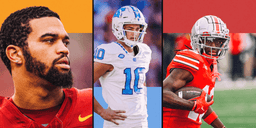
GO DEEPER
2024 NFL Mock Draft: After Super Bowl LVIII, how could the first three rounds look?
Training started at ground zero. Toni started working with Esa on basic football movements, on a patch of grass at a nearby duck pond. The early goal was to take the basketball movements Esa knew and morph them into something translatable for football. Part of why Esa took to pass protection so quickly is because of how similar a kick slide is to a defensive shuffle in basketball.
Advertisement
They drilled endlessly — one step at a time. Then they really started to sweat.
At the time, Toni, whose wife had recently given birth to their first child, was working the overnight shift at a nearby gym. His schedule was full, but he had an idea.
“We’d train all afternoon, until like 6:30 (p.m.) before getting home around 7,” Toni says. “I’d go take a nap until about 10:30. And I told him, you know, to make sure he relaxes a little bit — because when I get up, he’s coming to work with me.”
If Toni worked Esa on lower-body movements during the afternoon, he’d wring him out in the weight room with lower-body lifts until 1 a.m. Whatever muscle group the afternoon session focused on, the overnight work targeted the same. The brothers did this every day.
Esa eventually found an opportunity at Chabot College, a tiny juco program that plays in the California Community College Athletic Association. It’s about as far from Division I football as it gets.
When even that level of competition began to overwhelm Esa, Toni recentered his focus with a basic lesson in how football players — including those in the tiny CCCAA – were wired.

GO DEEPER
Jordan Palmer wants to change how we evaluate QBs. Kyle McCord is his 2025 NFL Draft test case.
“Every single kid out there had at least four years of playing before coming to juco. (They’re) pretty much all-stars from wherever they played in high school,” Toni said. “And, so, here you are. These guys are going to look at you like, ‘You think you can just show up and play the sport that I love?’
“We had to expedite the process. Every detail.”
Toni didn’t just teach Esa how the game works and how to change his body to survive in it, he also taught him how to strain like a football player. He taught the difference between being “hurt” and injured — which, in football, is everything.
Slowly, pain produced progress. Esa had never touched a weight before starting those overnight lifts with Toni, but he picked up the work quickly. An analytical thinker, Esa began to appreciate the process of challenging, changing and growing his frame. It got easier.
Advertisement
Never easy, mind you, but more manageable.
When he arrived at Chabot in spring of 2021 and saw that sunlight beaming through the glass, Esa was a different person. He was still unsure of a lot, but he’d completely committed to a dream that once felt impossible. He also had worked harder in the last year than most of his new teammates had in their playing lives, no matter how long they’d been around the game.
.@ShrineBowl WORK @esa_pole 📈😤 pic.twitter.com/QdInTfEw0p
— Washington State Football (@WSUCougarFB) January 28, 2025
Esa initially worked with the defensive line, but the Chabot coaches convinced him to try offensive tackle. He took to it like one of the ducks in that pond where he’d started training. Every mistake turned into an on-the-fly lesson in how the game works. Slowly, but surely, he started to feel at home.
So did Toni. After more than five years away from the game he loved, Toni joined the Chabot staff as defensive line coach — he helped encourage Esa to switch sides of the ball — and stayed until Esa received an offer to play at Washington State ahead of the 2023 season. Toni is now the D-line coach at Laney (Calif.) College.
Through each other, the brothers found their paths.
“Everyone has a different deck of cards dealt to them,” Esa says. “It’s just a matter of what you do with them.”
It’s hard to assign an exact draft stock to a player like Esa, in part because it’s impossible to compare him to his peers. He’s the only offensive lineman in this class who’d graduated high school before buckling up a chin strap.
His first season at Chabot was messy, but his work with Toni never stopped. When his teammates used downtime to get away from the game, Esa doubled down. The work ethic Toni ignited in him carried him early, and his natural athleticism took over from there — he finished his second year at Chabot as one of the top offensive tackles in juco football.
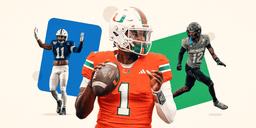
GO DEEPER
Feldman’s 2025 NFL mock draft: How coaches view Ward, Sanders, Hunter, Carter and more
His first year at Washington State was exactly like his first at Chabot. He looked like a potential star in September against Oregon State, only to give up nine pressures his next time out against UCLA. He was a mess against Arizona State, then turned in his best game of the year the following week against Stanford. Year 2 felt familiar, as his growth skyrocketed once more.
Advertisement
Pole gave up nine pressures in one game as a junior; he allowed just nine in his entire senior season. Per Pro Football Focus, Pole finished 2024 tied for the sixth-lowest pressure rate allowed among FBS offensive tackles — 2.2 percent, even with Missouri’s Armand Membou, a projected top-10 pick this spring.
“My O-line coach, Jared Kaster (who’s now at Wake Forest), kind of revolutionized the game for me,” Esa says. “He really got it through to me, and it clicked, like, every play there’s another man out there trying to take your man card. Are you going to let him take it? Or are you going to take his?
“Every other position on the field can get away with loafing. We don’t loaf as offensive linemen. If we do, somebody could really get hurt.”
Pole wrapped his college career auditioning for NFL scouts at the Shrine Bowl in Dallas, wearing a smile big enough to see all the way back in California.
As for now, the training continues. No one’s quite sure where Pole will land on the final draft board, or if he’ll have to take a chance as an undrafted free agent. He’ll attack either scenario with the same attitude and passion he’s shown these last four years — with hope, confidence and gratitude.
“It’s interesting, people will look at him play and tell me, ‘Man, he’s supposed to be here — he makes it look easy,’” says Toni of Esa. “Easy? They don’t know what it took to get here, how he buried himself in work.
“We didn’t have a lot growing up, you know. And to see how far he’s come, it’s just beautiful.”
(Top photo: James Snook / Imagn Images)
This post was originally published on this site be sure to check out more of their content.




